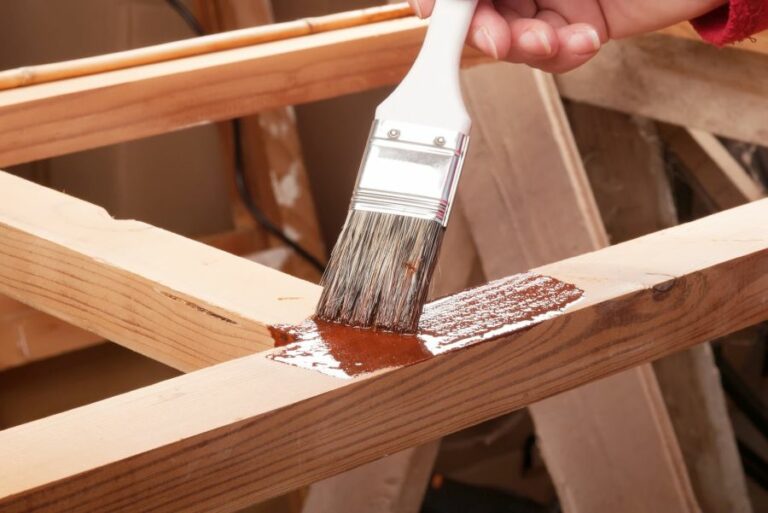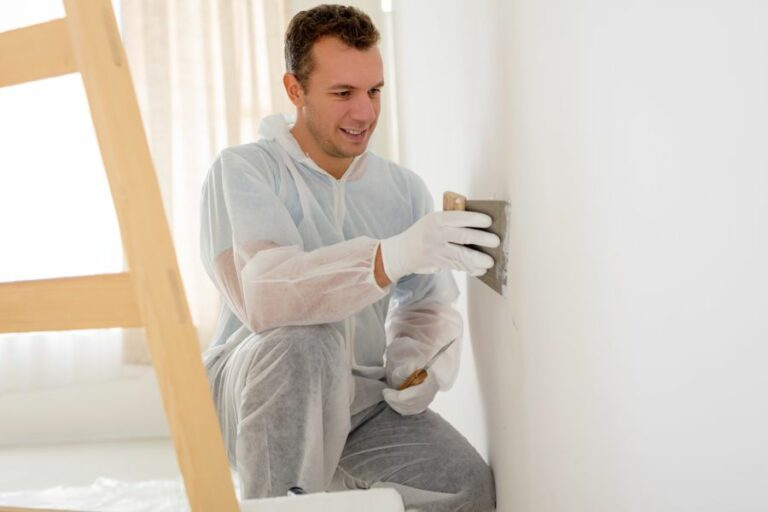Ideal Conditions For Surface Preparation. What Pros Say
Are you looking to achieve the best possible results in your surface preparation process? You’ve come to the right place! We understand how crucial it is to create the ideal environment for a successful application, and we’re here to guide you through it. With our expertise in surface preparation, we have the answers you need.
Ideal conditions for surface preparation:
Ideal conditions for surface preparation include maintaining a temperature between 50°F (10°C) and 100°F (38°C), ensuring a relative humidity between 40% and 60%, and avoiding inclement weather or heavy winds. Utilize appropriate cleaning, masking, and sanding techniques, and prioritize personal and environmental safety during the preparation process.

Discover the secrets to achieving a flawless surface that ensures optimum adhesion, longevity, and performance of coatings, overlays, and treatments.
Dive into the best practices, latest techniques, and innovative tools for surface preparation. Read on for expert advice to master the art and science of creating ideal conditions for your projects!
Contents
- 1 Optimal Conditions for Surface Preparation
- 2 Necessary Conditions for Effective Surface Coating
- 3 Key Considerations in the Surface Preparation Process
- 4 Factors for Evaluating Surface Preparation Needs
- 5 Monitoring Atmospheric Conditions Prior to Coating Application
Optimal Conditions for Surface Preparation
Surface preparation is a critical step in any construction, restoration, or painting project. Properly preparing surfaces, whether it’s wood, metal, or concrete, ensures superior and long-lasting results.
• Optimal Environmental Conditions
– Temperature
Temperature plays an important role in the adhesion and curing process of various materials. The recommended range for most applications is between 50°F (10°C) and 100°F (38°C).
If the temperature is too low, materials such as paint, sealant, or adhesive may not adhere properly, and curing may take longer. Similarly, high temperatures can cause these materials to dry too quickly, leading to cracks and poor adhesion.
For best results, it is crucial to stay within the manufacturer’s recommended temperature range during the surface preparation and application process.
– Relative Humidity
Relative humidity (RH) also impacts the effectiveness of surface preparation. High humidity levels can slow down curing and drying times, as well as promote the growth of mold and mildew.
On the other hand, extremely low humidity levels can cause materials to dry too quickly, again leading to cracks and poor adhesion. Ideally, the relative humidity should be between 40% and 60% during the surface preparation process.
It is worth investing in a hygrometer to measure and monitor the humidity levels at your job site.
– Weather Conditions
Monitoring weather conditions is vital to ensure work quality, particularly for outdoor surface preparation projects. Rain or snow can rapidly compromise the prepared surface, as moisture ingress is detrimental to most materials.
Avoid carrying out surface preparation work during inclement weather or forecasted precipitation. Furthermore, heavy winds can disperse debris and contaminants onto the prepped surface, significantly impacting the quality and desired results.
• Adequate Surface Preparation Techniques
– Cleaning
Proper cleaning is essential to remove any surface contaminants, such as dirt, grease, or existing paint, that can obstruct adhesion. Depending on the material type and contaminant level, various cleaning methods can be employed, including:
- Pressure washing: Recommended for exterior surfaces and large areas.
- Hand washing: Appropriate for smaller or delicate surfaces.
- Solvent cleaning: Recommended for greasy or oily surfaces.
- Abrasive cleaning: Effective for removing paint, rust, and other adherent materials.
– Masking
Meticulous masking is crucial to avoid damage to adjacent surfaces and ensure clean, sharp finishing lines. Various masking materials, such as tape, plastic sheeting, or masking paper, can be used, depending on the project’s requirements.
In addition, proper technique during the removal of masking can prevent damage to the freshly prepped or painted surface.
– Sanding
Sanding is a common technique for preparing wood, metal, or concrete surfaces to ensure optimal adhesion of paint, adhesives, or sealants. Depending on the desired finish, the appropriate sandpaper grit, sander type, and sanding pressure should be carefully selected.
• Safety Measures During Surface Preparation
To ensure personal and environmental safety during surface preparation, certain precautions must be undertaken:
- Utilize appropriate personal protective equipment (PPE), such as gloves, goggles, and respirators.
- Ensure proper ventilation in enclosed spaces to minimize the inhalation of potentially hazardous dust or fumes.
- When using chemicals or solvents, follow the manufacturer’s guidelines for application, handling, and disposal.
• Key Takeaways
In summary, creating the ideal conditions for surface preparation plays a crucial role in ensuring the success and durability of a project.
The right environmental conditions, appropriate cleaning and preparation techniques, and the use of suitable equipment will all contribute to a high-quality outcome. Finally, always prioritize safety during surface preparation work, protecting both yourself and the environment.
Necessary Conditions for Effective Surface Coating
Surface coating is a critical process in various industries, including automotive, aerospace, and construction sectors, to protect and enhance the properties of the underlying material. The effectiveness of a coating depends on the conditions it is applied under.
• Importance of Surface Preparation
One of the most crucial aspects of surface coating is surface preparation. Proper surface preparation is vital for a successful coating as it ensures optimal adhesion and performance. Some of the recommended methods for surface preparation are:
– Mechanical Cleaning
Mechanical cleaning, also known as abrasive blast cleaning, uses tools such as sanders, grinders, and rotary brushes to remove dirt, rust, and other contaminants. For optimum results, choose an abrasive that suits the substrate being treated.
– Chemical Cleaning
Chemical cleaning, such as degreasing, involves the use of solvents, detergents, or acids to remove contaminants from the surface. This process can effectively eliminate grease, oils, and dirt from surfaces.
– Surface Profiling
Surface profiling involves creating a uniform and rough texture on the material’s surface, which helps promote adhesion between the coating and the substrate. Methods such as grit blasting or acid etching can be used to achieve this profile.
• Environmental Factors in Coating Application
The environmental conditions during the application of a surface coating can significantly impact the quality and performance of the applied coating. Some environmental factors to consider include:
– Temperature
Applying a coating at the recommended temperature range ensures that the material flows and cures correctly, providing optimal performance. Avoid applying a coating during extreme temperatures, as they may lead to poor adhesion, cracking, delamination, or discoloration.
– Humidity
High humidity can negatively influence a coating, as it may cause condensation on the surface, leading to adhesion and curing issues. Always check the manufacturer’s recommendations for appropriate humidity levels during the application of a coating.
– Ventilation
Proper ventilation is crucial during coating applications, as it prevents the accumulation of hazardous fumes, maintaining a safe working environment. Moreover, adequate airflow ensures the proper evaporation of solvents, which impacts the drying and curing of the coating.
• Material Considerations for Coating Selection
Different materials require different coating types for optimal protection and performance. Some factors to consider when selecting a surface coating include the following:
– Substrate
The composition of the underlying material plays a critical role in the compatibility and adhesion of the coating. For instance, coatings for metals should be resistant to corrosion, while coatings for plastics need to be flexible and compatible with the plastic to avoid cracking or delamination.
– Coating Properties
Select a coating with properties that match the intended application and the environment in which the coated material is expected to perform. Important properties to consider include:
- Chemical resistance
- UV resistance
- Abrasion resistance
- Antifouling properties
- Thermal insulation
– Compatibility with Existing Coatings
In some cases, a new coating may need to be applied over an existing one. It’s crucial to ensure compatibility between the coatings to avoid issues such as poor adhesion, wrinkling, or lifting of the existing coating layers.
• Importance of Appropriate Coating Techniques
Different coating techniques have their specific advantages, applicability, and limitations. These techniques include spraying, rolling, brush application, and dipping.
Selecting the appropriate coating technique can significantly impact the quality, durability, and cost-effectiveness of the applied coating. Factors to consider when choosing a coating technique include the type of coating, substrate, environmental conditions, and application requirements.
• Inspection, Testing, and Quality Control
Ensuring the quality of the applied surface coating is essential for the overall performance and durability of the coated material. Regular inspection and testing procedures should be in place during the coating process to identify and rectify any defects.
This ensures an effective coating is achieved, meeting necessary standards and requirements.
In conclusion, understanding the conditions under which a surface coating is applied is crucial for optimal performance and protection.
Choosing the appropriate preparation techniques, coating materials, and application methods and providing suitable environmental conditions are some factors that contribute to a successful surface coating.
By taking care of these aspects, the surface coating’s long-term durability, protection, and finish quality can be ensured.
Condition | Description |
|---|---|
Surface preparation | The surface must be properly cleaned and free from contaminants like dirt, oil, and rust before coating application. |
Environmental conditions | Temperature, humidity, and air quality can significantly affect the performance of a surface coating. It is important to ensure that conditions are within the recommended range for a specific coating product. |
Coating selection | Choose a coating that meets the specific requirements of the application, such as durability, corrosion resistance, and desired appearance. |
Proper application | Follow the manufacturer’s instructions for applying the surface coating, including recommended application techniques, number of coats, and cure times. Improper application can lead to poor performance of the coating. |
Inspection and testing | Regularly inspect and test the coating to ensure it is maintaining desired properties and performing effectively. Address any defects or issues promptly. |
Key Considerations in the Surface Preparation Process
Preparing a surface correctly before applying any paint, coating, or adhesive is vital to ensure a long-lasting and durable finish. Surface preparation is essential in any painting or coating project, be it on a building, automobile, or any other material.
The longevity, appearance, and even the final product’s performance can be directly linked to the quality of surface preparation.
• Assessing the Surface Condition
One of the crucial factors in surface preparation is assessing the current condition of the material. This step helps in determining the appropriate treatment to apply.
- Cleanliness: The surface must be free from dust, dirt, grease, oil or any other contaminants. This is because the presence of these elements can adversely affect the adherence and bonding of the paint, coating, or adhesive.
- Existing Coatings: If the surface has any existing paint or coating, it is necessary to determine its condition and compatibility with the new material. Sometimes, removing the existing coating can be more effective than treating and applying a new layer.
- Damages: Surface damages like cracks, holes, or roughness can affect the final product’s performance and appearance. Repairing these damages before any treatment is essential for better results.
• Choosing the Right Surface Preparation Method
There are several surface preparation methods available, depending on the type of surface, material, and desired final product. It is essential to choose the right method to ensure the longevity and performance of the final product. Some commonly used methods include:
– Abrasive Blasting
Also known as sandblasting, this method involves propelling abrasive particles at high speed onto the surface. This process removes contaminants, roughens the surface, and creates a profile suitable for the new paint or coating.
Abrasive blasting is recommended for surfaces with heavy rust, peeling paint, or thick, uneven coatings. However, it might not be suitable for sensitive or delicate surfaces.
– Chemical Cleaning
There are numerous chemical cleaners available to remove oil, grease, dirt, and other contaminants from the surface. Some also provide a temporary layer of protection against further contamination.
Selecting the appropriate cleaner based on the type of surface and contaminants involved is crucial to achieving the desired results.
– Power Washing
Power washing is applicable for surfaces that require a thorough cleaning but not the removal of paint or coatings. It is an effective way to remove dirt, mildew, and other contaminants without damaging the underlying material.
Bear in mind that excessive pressure during power washing can cause damage to the surface, so it is essential to choose the right power washer and pressure level.
– Mechanical Surface Preparation
Methods like grinding, sanding, and brushing can be used for mechanical surface preparation. These techniques remove surface debris, old paint, or coatings and create a suitable profile for the new material. Mechanical surface preparation is commonly used for surfaces like wood or concrete.
However, these methods can generate dust or debris, so proper clean-up is necessary before applying the new material.
• Implementing the Correct Procedures
Following the correct procedures during surface preparation is essential for ensuring the effectiveness of the method. This includes:
- Safety: Proper safety measures like wearing appropriate personal protective equipment (PPE) and following recommended guidelines should be observed. In case of hazardous materials or waste disposal, complying with local regulations is necessary.
- Time: Proper timing in surface preparation is crucial, as some surfaces may deteriorate or be affected by weather conditions if left untreated for an extended period. Similarly, applying paint or coatings too soon after surface preparation can affect the results.
- Testing: Performing tests like adhesion and infiltration tests can help ascertain if the surface preparation has been successful in achieving the desired results. Testing could help identify any issues and determine the necessary corrective measures.
• Conclusion
In summary, surface preparation is a vital step in any project involving paint, coatings, or adhesives. Assessing the surface’s condition, choosing the right preparation method, and following the correct procedures are the factors that must be considered during surface preparation.
Proper surface preparation ensures a successful application and a durable, long-lasting final product.
Factors for Evaluating Surface Preparation Needs
Surface preparation is a crucial step in ensuring the long-term performance and integrity of a vessel. By adequately preparing a surface, you can ensure proper adhesion of coatings, prevent corrosion, and increase the overall lifespan of the vessel.
• Assessing the Current Condition
Before starting, it is essential to assess the current condition of the surface. This includes identifying areas where corrosion, damage, or contamination is present and estimating the extent to which these issues are prevalent.
A thorough inspection should be conducted to identify any signs of deterioration that may require immediate attention or special preparations.
• Determining the Appropriate Surface Preparation Method
There are various methods available for surface preparation, and choosing the most suitable one depends on the current state of the vessel and the desired end result. Some of the most common methods include abrasive blasting, power tool cleaning, and chemical cleaning.
– Abrasive Blasting
Abrasive blasting is a highly effective method for removing rust, old paint, and other contaminants from a vessel’s surface. This method uses high pressure to propel abrasive particles against the surface, resulting in a clean and roughened profile that promotes coating adhesion.
It is crucial to select the appropriate abrasive material and blasting equipment for the specific project to achieve the best results.
The Society for Protective Coatings (SSPC) offers guidelines for selecting suitable abrasive materials and blast cleaning standards.
– Power Tool Cleaning
Power tool cleaning is ideal for smaller projects or areas where abrasive blasting is less feasible. This method involves using power tools such as grinders, sanders, and needle guns to remove old coatings, rust, and other contaminants from the vessel’s surface.
The effectiveness of power tool cleaning is dependent on the operator’s skill and the type of tools used. The International Organization for Standardization (ISO) provides guidelines and requirements for various degrees of power tool cleaning.
– Chemical Cleaning
Chemical cleaning is an effective method for removing contaminants and paint layers from a vessel’s surface without causing damage or substantial roughening.
This method involves the application of specialized cleaning solutions that penetrate contaminants and break down paint layers, allowing them to be easily removed.
Appropriate safety measures, such as proper ventilation and personal protective equipment (PPE), must be considered when using chemical cleaning products.
• Coating Selection and Compatibility
Selecting the right coating for the vessel’s surface is crucial. The choice of coating depends on factors such as the vessel’s operating environment, expected performance requirements, and compatibility with existing coatings.
It is vital to consult with coating manufacturers to obtain recommendations and ensure that the selected coating is suited to the vessel and compatible with the chosen surface preparation method.
• Environmental Conditions
Environmental factors, such as temperature, humidity, and wind, play a significant role in the success of a surface preparation project. Adverse conditions can result in an uneven surface profile or reduce the effectiveness of coatings, leading to premature failure.
It is crucial to monitor and control these conditions throughout the surface preparation process to ensure optimal results. The SSPC and NACE provide guidelines for optimal environmental conditions during surface preparation and coating application.
• Worker Safety and Health
Ensuring worker safety is of paramount importance during surface preparation. Appropriate measures should be taken to minimize the risk of injury due to direct contact with machinery, hazardous chemicals, and airborne particles during abrasive blasting or chemical cleaning.
This includes mandatory use of appropriate PPE, proper ventilation and dust extraction systems, adherence to safety guidelines and regulations, and proper worker training.
• Waste Management and Disposal
The disposal of waste materials generated during surface preparation, such as used abrasive media, paint chips, and chemical residues, should be handled properly to mitigate any potential harm to the environment, worker safety, and regulatory compliance.
It is essential to identify and adhere to local, state, and federal guidelines on proper waste disposal and consider implementing recycling and reclamation programs for reusable materials when possible.
• Quality Control and Documentation
Proper documentation and quality control ensure that the surface preparation process is carried out according to set standards and requirements.
Detailed records should be kept on environmental conditions, coating material and application details, procedures, and personnel involved in the project.
Regular inspections and monitoring should be carried out to ensure that the process is on track and deviations from the established plan are appropriately addressed.
In conclusion, a successful surface preparation project requires careful consideration of various factors, including the vessel’s condition, selected preparation method, environmental conditions, coating compatibility, worker safety, and waste management.
Adherence to established guidelines and industry best practices is crucial for optimal project outcomes and long-term vessel performance. With the right approach, you can extend the life of your vessel, protect it from corrosion, and maintain its structural integrity.
Emphasizing the importance of detailed planning, safety, and quality control will go a long way toward ensuring the success of your surface preparation project.
Factors | Description |
|---|---|
Type of Vessel | Consider the size, shape, and material of the vessel to determine the appropriate surface preparation technique. |
Intended Use | Determine the intended use of the vessel and its contents, which could affect the requirements for surface preparation. |
Surface Condition | Evaluate the existing surface condition for any contaminants, corrosion, or defects that may require specific surface preparation techniques. |
Surface Preparation Standard | Choose the suitable surface preparation standard based on the vessel’s material and industry requirements. |
Coating System | Consider the type of coating system to be applied, as this can impact the surface preparation requirements. |
Environment | Take into account the environment in which the vessel will operate, as this can influence the level of surface preparation needed to ensure durability. |
Time and Budget | Factor in the available time and budget for the project, as certain surface preparation methods may be more cost-effective and time-efficient than others. |
Health, Safety, and Environmental Concerns | Address any health, safety, and environmental concerns associated with the surface preparation process, such as dust generation or chemical waste disposal. |
Monitoring Atmospheric Conditions Prior to Coating Application
Coating application is a crucial step in protecting substrates from potential deterioration due to environmental factors such as corrosion, UV radiation, and chemical exposure.
To achieve a durable and long-lasting coating, it is essential to consider atmospheric conditions before, during, and after application.
• Temperature and Relative Humidity
Temperature and relative humidity (RH) play a significant role in the drying and curing of a coating. Monitoring these parameters is essential to determine the appropriate time to apply the coating and to avoid any adverse effects on its performance.
– Temperature
Coating manufacturers provide guidelines on the recommended temperature range for the application. Typically, the optimal temperature for most coatings is between 50°F and 95°F (10°C and 35°C).
Applying coatings outside this range may result in improper drying, curing, or film formation, leading to poor adhesion and compromised performance.
It is also worth noting that temperature variations during the application and curing period can affect the final coating properties. For instance, a sudden drop in temperature can lead to uneven drying or the formation of defects.
– Relative Humidity
High relative humidity may lead to condensation on the substrate surface, which can negatively affect the adhesion of the coating. It is generally recommended that the RH should be below 85% during application and curing.
Furthermore, high humidity levels can prolong drying and curing times, which may require adjustments to the recoating intervals. Consult the coating manufacturer’s guidelines to determine the appropriate RH levels for application and curing.
• Dew Point and Surface Temperature
The dew point is the temperature at which air can no longer hold moisture, resulting in condensation. It is imperative to evaluate the dew point and surface temperature of the substrate to avoid applying coatings when the risk of condensation is high.
– Dew Point
To determine the dew point, use a dew point meter or refer to a psychrometric chart based on the air temperature and relative humidity measurements.
– Surface Temperature
Substrate surface temperature can significantly impact coating adhesion and performance. Surface temperatures should be higher than the dew point to prevent condensation and accommodate the coating’s recommended application temperature range.
There are various techniques, such as infrared thermometers or surface temperature probes, to measure substrate surface temperatures accurately. It is essential to measure multiple locations on the surface to account for potential temperature variations.
• Wind Speed and Air Movement
Wind speed and air movement can influence the drying and curing of a coating, as well as the dispersion of particulate matter onto the substrate surface.
– Wind Speed
High wind speeds can increase the evaporation rate of solvents in the coating, leading to a faster drying time and potential defects such as pinholes, blisters, and solvent entrapment.
On the other hand, low wind speeds may prolong the drying and curing process, extending the window of vulnerability to contamination.
To prevent adverse effects due to wind, it is advisable to monitor wind speed during coating application and, if possible, set up wind barriers to protect the area.
– Air Movement
Airborne particles, such as dust and debris, can contaminate the wet coating surface, leading to defects and potentially compromising the coating’s performance. Proper air movement is essential to minimize the risk of particle contamination during application.
Consider establishing a clean and controlled environment, such as setting up a temporary enclosure or using air filtration systems, to maintain air quality during coating operations.
• Conclusion
Understanding and monitoring the atmospheric conditions before applying a coating is crucial to achieving a durable and long-lasting protective finish.
Paying close attention to temperature, relative humidity, dew point, surface temperature, wind speed, and air movement can help ensure that the coating is applied and cured under optimal conditions, resulting in a successful protective system.
For more information on controlling atmospheric conditions, the American Coatings Association provides relevant guidelines and resources to assist in selecting and applying the appropriate protective coatings under various environmental conditions.
Atmospheric Condition | Description |
|---|---|
Temperature | Both the air and the surface temperature should be within the recommended range specified by the coating manufacturer. |
Humidity | The relative humidity should be within the limits specified by the coating manufacturer to ensure proper curing and adhesion. |
Dew Point | The surface temperature should be at least 3C (5F) above the dew point to prevent moisture from condensing on the surface during the application process. |
Wind Speed | High wind speeds can cause various issues, such as overspray and uneven drying. It’s essential to monitor wind speeds and conditions during the application process. |
Air Quality | Monitoring air quality helps ensure proper ventilation and reduces the risk of contamination from dust, dirt, or other airborne particles that can affect the coating. |







